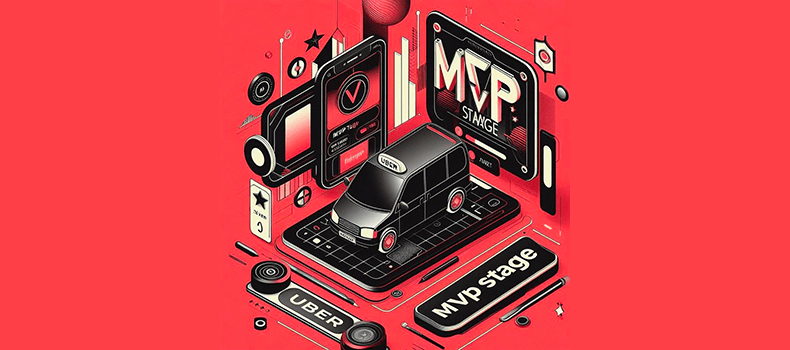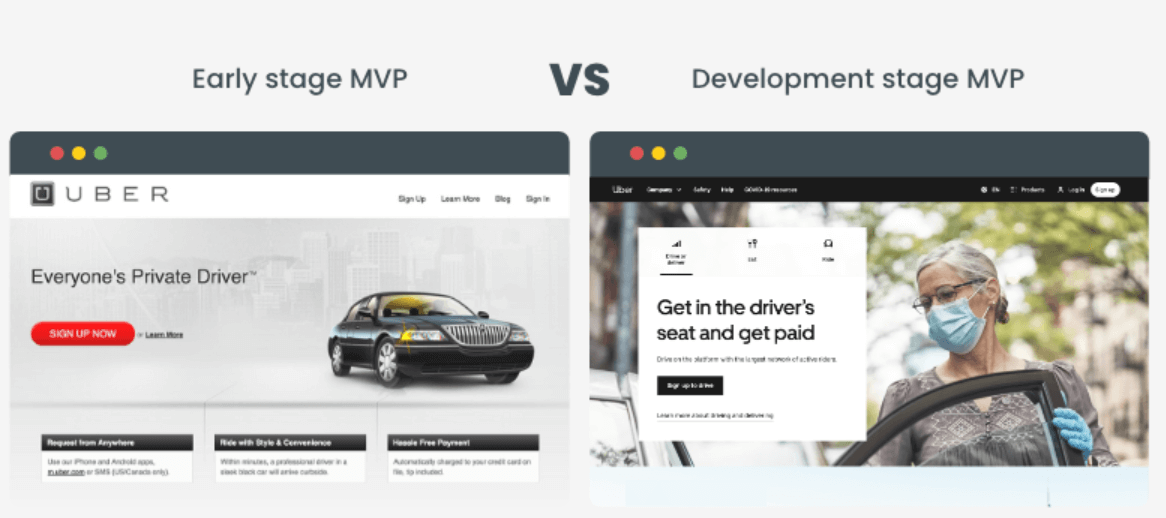Feb
6
Uber: How MVPs Birthed a Technology Titan

Did you know that Uber was inspired by James Bond?
Since January 2024, Uber is valued at almost $74.7 billion! But how did this on-demand service begin exactly?
Many years ago, co-founder Garrett Camp, used to live in San Francisco, where he faced cabs being unavailable all the time! Along with this, there were unreliable drivers, and very poor customer service.
He found his Eureka moment while watching Daniel Craig track a car using a mobile phone in one of the Bond movies. He was sold on the aspect of tracking the location of a cab!
Garrett noticed the cracks in the taxi system: unreliable, dingy, and frustratingly scarce. He decided to pave over them with a user-friendly app- a sleek portal to on-demand rides, with safety, reliability, and shiny-sparkling interiors. These rides would be available at any hour, slowly increasing the city areas to test the service in.
This app aimed to rewrite the rules of urban mobility, offering convenience and peace of mind with every tap of the screen.
How did it all begin?
When these two incredible minds met, they decided to check the demand for this service promptly. This led to the creation of “Uber Cab”- the first MVP for a service that we would know by the name of “Uber”.
This initial prototype only focused on providing a simple, but reliable transportation service. This led to preliminary market checks and validating the proof of concept. This on-demand service was tested in San Fransisco and New York firsthand at the start of 2010.
They only had a few cars registered back then, but the user-friendly application captured many users in no time. It became a normal thing to order a cab with a single click on the phone.
Exploring the MVP
The first rendition included customers texting their addresses on the mobile app. This allowed connecting with cabs in the vicinity.

Integrating API
After winning over a small market, the founders decided to update the MVP iteratively through constant feedback. Eventually, UberCab partnered with a third-party mapping API- Google Maps. This removed the need for an in-house dev team and ensured real-time location accuracy from the start.
These integrations allowed the company to add a myriad of features like live tracking, splitting the fares & cost estimates for the rides.
Targeting Initial Users
The company approached existing luxury cab and limo drivers. They already had a successfully running business, making it much easier to get them on board.
Early Adopter Customer Strategy
Amidst the trends of city-wide tech events, UberCab offered a chance at experience the future- free cab rides for the young & smart tech-savvy professionals; a sleek upgrade to their usual commute.
This made the target audience experience the primary features of the initial app:
- Tracking the ride through accurate location pinpointing.
- Accessing the user-friendly app.
- Timeliness in arriving of the driver.
- It also showcased how professional these drivers were and their commitment to safety & hygiene, inculcating a sense of trust and excitement.
Travis Kalanick says that the ‘Uber’ became the pinnacle of word-of-mouth marketing, with people simply asking each other “Who’s ubering today?”
Well, how did the MVP help Uber then?
Uber’s swift rise wasn’t a direct head-on battle with the conventional taxis. Instead, it was a strategic dive into the vast ‘blue ocean’- a market space with a huge undisputed value.
You ask what drove this into success?
Uber’s Minimum Viable Product (MVP)
- Ease of Technology: The UberCab app, the first in this industry, transformed car-hailing into a seamless click-and-go user experience.
- Value Innovation: It offered crystal-clear pricing, making cost estimation a leading expectation. A few features like live tracking & driver ratings added extra layers of trust and control, resulting in an enriched passenger experience.
- Breaking the Ownership Constraint: Car ownership suddenly became optional. UberCab’s on-demand availability confronted the conventional paradigm, liberating users from the burden of vehicle maintenance and parking troubles.
- Targeting new markets: UberCab focused on an untapped market – tech-savvy professionals who value automation, convenience and flexibility.
- Ubercab’s MVP leveraged a peer-to-peer network of drivers. This asset-light approach allowed for rapid scalability and adaptation.
- Drives with Data: Every fared ride generated real-time critical data- from travel patterns to driver behaviour. These real-time capabilities allowed continued iteration, route optimization, and services offered, ensuring a smooth journey every time.
Uber linked its sturdy brand image with innovation, convenience and accessibility. This automation caused a disruption in the transportation industry.
Uber’s success eventually revolutionized urban mobility.
This early version was far from the sleek interfaced app that we know and use today. Think bare-bones- a seamless and simple experience for on-demand cabs, limited to a handful of cars in San Francisco only.
But with this stripped-down functionality, also came the early seeds of a revolution.
Why should businesses trust MVPs?
Let’s forget the “build it and they will come” mentality- in today’s evolving markets, launching a full-fledged product can lead to a disaster. Businesses go through constant upgrades, different strategies and ideas every day.
It’s crucial to understand how each idea or strategy would perform in the market without investing unlimited resources in one.
Enter the MVP- a lightweight, data-powered tool that allows businesses to explore market uncertainties and thrive towards success.
1. Agile Validation:
MVPs are efficient and low-cost. Quick deployment, real-world insights and validation of early assumptions is possible by using this, before starting full-scale development.
2. Continuous Learning Engine:
Businesses can easily access priceless feedback from initial users. This leads to leveraging data for rapid iteration, fine-tuning features, and product optimization for a perfect market fit.
3. Risk Mitigation:
MVPs allow early identification of deal breaking flaws and market disarray. This allows businesses to refine the value proposition and avoids development of products that have no market demand.
4. Resource Optimization:
We say agile development FTW!
MVPs enable companies to introduce features in phases, resulting in continual testing and optimization.
5. Rapid Feedback Loop
The MVP acts like a walkie-talkie. It establishes a direct line of communication with your target audience, allowing continual feedback that keeps the product in groove with the market demands.
P.S. Did you know that MVPs allow 43% faster time-to-market giving businesses a first-mover advantage, potentially gaining market share and establishing brand dominance? (Mckinsey & Company 2023)
7 Essentials to look for in your ideal tech partner!
-
1. A healthy mindset of rapid time-to-market
An ideal tech partner must strive to have an in-depth understanding of your requirements and business goals. With this knowledge, the team’s expertise should let you launch your product early in the market, allowing you to have quicker iterations of your product based on user feedback.By leveraging this mindset, you can fasten your development cycles and fulfill user demands quicker than planned.
-
2. Expertise in cross-technologies
With increasing global interconnectivity, you need a partner who is fluent in multiple languages of the cloud, AI, software development and more. A tech partner should have a wide array of technologies up their sleeves. This allows you to anticipate future trends better while bridging the gaps by using fresh tech to build your product.By seeking such diverse teams with multiple technology expertise, you should have a partner who doesn’t just offer tools, but also unlocks the full potential of your product through API integrations to AI-powered analytics and beyond.
-
3. Industry-wide exposure
Potential tech partners should be well-versed in various (& your industry’s) industries’ workings and technical know-hows. They should be able to conduct an immediate SWOT analysis of your industry.Believe us, it’s not wrong to expect your tech partner to be an extension to your own team, speaking your language and anticipating your needs!
That’s why your chosen tech partner needs to have multifaceted competency to create seamlessly integrated solutions that work to give you optimal results.
-
4. Competitive Pricing
A qualified tech partner should have your best interests in their mind, including having competitive pricing for you to be comfortable. They should know that value transcends just functionality.Your chosen tech partners must have transparent pricing models, free of hidden fees, for you to understand your investment better. Such teams should discuss your goals and make solutions that fit your financial terrain, not the other way around.
-
5. Able to deliver what’s promised, on time and within budget
Always think- reliability, not just possibility.Your potential tech partner should be accountable for their work and mistakes, if any. This means that they will go to all lengths to deliver what’s planned, without causing needless friction.
Tech partners should have transparent processes that keep you informed at every step and have agile methodology that will ensure adapting to evolving needs without compromising the set deadlines.
Investing in a team’s expertise and open communication is going to get you the wanted results.
-
6. Divulge into newer and adventurous software
Your chosen tech partner should have the thrill of looking for the unexplored. In this tech landscape, stagnation is a pursuit towards obsolescence. These teams should possess a voracious appetite for devouring nascent frameworks to unlock newer and efficient ways of developing your perfect market fit -
7. Steadfast about empowering businesses in all scales of development
Whether you’re a young startup taking flight or an established titan navigating newer markets, the right tech partner will support you no matter what. Ideal tech partners should have a mindset of giving every business, no matter the size of stage, access to the correct tools and expertise.
Looking for the right technological partner?
At iProgrammer, our elite team is a master at translating your needs into elegant and scalable solutions. We wield the best-in-class tools and frameworks like Azure, Tableau, React.js, Angular, and so many more, to craft pixel-perfect experiences that propel you towards market domination.
With us by your side, you’ll never get bored of your tech partner, but rather find a constant ally, pushing you forward on your quest towards success.
We don’t just promise results; we guarantee them.


















































